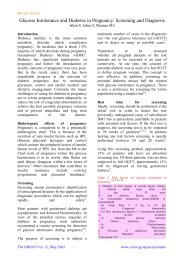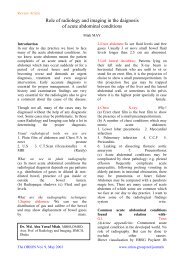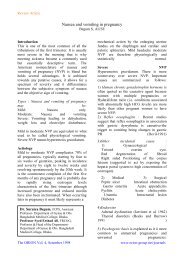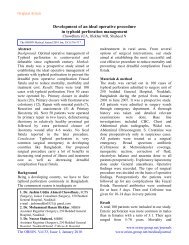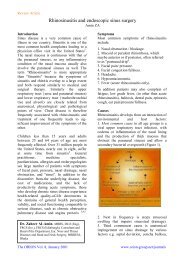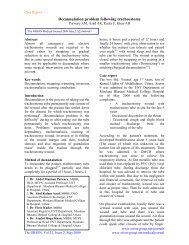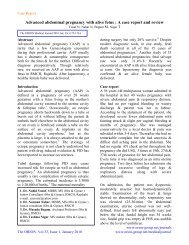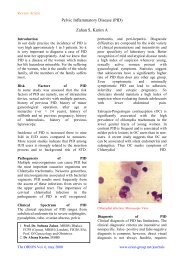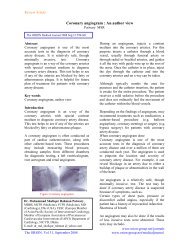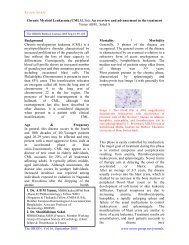PDF - Orion Group
PDF - Orion Group
PDF - Orion Group
Create successful ePaper yourself
Turn your PDF publications into a flip-book with our unique Google optimized e-Paper software.
Editorial<br />
Scaling up zinc treatment: Involving pediatricians<br />
Sultana S, Shakur MS, Larson CP<br />
The ORION Medical Journal 2005 Sep;22:290<br />
Globally, about 10.8 million under-five year<br />
old children die every year. Ninety percent of<br />
these deaths occur in developing countries. In<br />
South Asia almost one in ten children die<br />
before their fifth birthday 1 . Diarrhea is one of<br />
the leading causes of morbidity and mortality<br />
among these children. Diarrheal diseases are<br />
the cause of almost two million deaths<br />
annually 2,3 mainly among children less than 5<br />
years of age.<br />
It is well documented that diarrhoeal episodes<br />
last longer in children who are underweight<br />
and have a low level of (cellmediated)<br />
immunity. Both of these can result from zinc<br />
deficiency. A relationship between zinc and<br />
diarrhea was shown in a study in whichl2-59<br />
month-old Indian children with zinc<br />
deficiency were found to have 1.5 times more<br />
diarrhea than those without 4 .<br />
The World Health Organization sponsored a<br />
meeting in New Delhi which summarized the<br />
current knowledge on the effects of zinc<br />
supplementation on the management of acute<br />
diarrhea. All the available published and<br />
unpublished studies on this topic, conducted<br />
both in hospitals and in the community, were<br />
reviewed. It was concluded that zinc<br />
treatment, given at a dose of about double<br />
recommended daily allowances (RDAs) per<br />
day (10 to 20 mg per day) for 14 days, can<br />
significantly reduce the severity of diarrhea as<br />
well as the duration of episodes 5 . In 2004,<br />
WHO and UNICEF gave a joint statement on<br />
management of diarrhea where they<br />
1. Dr. Samina Sultana, MBBS Training coordinator,<br />
SUZY Project, ICDDR,B<br />
2. Prof.Md. Salim Shakur, Phd, FRCPCH (UK),<br />
FRCP (London), FRCP (Edin) FRCP (GIassgow),<br />
MRCP (UK, DCH (Glassgow), DCH (Dublin), MBBS<br />
(Dhaka) Director, Senior Consultant & Member,<br />
Management board, Dhaka Shishu Hospital.<br />
3. Dr.Charles P.Larson, MD, CM, FRCP (C)<br />
Director, Health System & Infections Diseases<br />
Division, P1 SUZY Project, ICDDR,B<br />
The ORION Vol. 22 Sep 2005<br />
recommended to provide the children with 20<br />
mg per day zinc supplementation for 10-14<br />
days (10 mg per day for infants under six<br />
months old 6 ). This year zinc was incorporated<br />
in the essential drug list of WHO.<br />
Diarrhea is one of the leading causes of death<br />
among Bangladeshi children. A study<br />
conducted by ICDDR, B showed that 20% of<br />
under five years old death is associated with<br />
diarrheal diseases, in Bangladesh. In addition<br />
children in Bangladesh experience an average<br />
of 3 to 4 episodes of diarrhea per year 7 .<br />
Given zinc treatment of diarrhea has the<br />
potential to reduce diarrhoea morbidity and<br />
subsequent mortality, ICDDR, B applied for<br />
funding to support the ‘Scaling up Zinc<br />
Treatment for Young Children with Diarrhea<br />
(SUZY)' Project. Funding was received from<br />
the Bill and Melinda Gates Foundation. The<br />
goal is to set the program on a path to reach<br />
all children of Bangladesh, regardless of<br />
gender, income or where they live in<br />
providing zinc as a treatment for any diarrheal<br />
disease episode.<br />
Paediatricians in Bangladesh are the top line<br />
of care providers for children. The licensed<br />
general private health care providers usually<br />
follow the practices and guidance of<br />
pediatricians. They in turn influence other<br />
providers. The Bangladesh Pediatric<br />
Association (BPA) provides expert<br />
recommendation on child health care to the<br />
Government of Bangladesh and the Ministry<br />
of Health and Family Welfare (MOH-FW) on<br />
a number of issues. Given their importance,<br />
the SUZY project organized a series of<br />
workshops with the pediatricians from the 6th<br />
to 9th December 2004 to sort out the<br />
appropriate plan to involve the pediatricians<br />
in the project. The participants of all the<br />
sessions were interactive and enthusiastic.<br />
Majority of the Pediatricians including<br />
national professor MR Khan, Director of<br />
www.orion-group.net/journals
Editorial<br />
Dhaka Shishu Hospital Professor Salim<br />
Shakur appreciated that appropriate steps for<br />
scaling up zinc treatment in under five years<br />
old children with diarrhea are being initiated<br />
in Bangladesh. Dr. Chowdhury Md. Haider<br />
AD, Secretary General of Bangladesh<br />
Paediatric Association (BPA) proposed to<br />
organize seminars with pediatricians through<br />
the BPA to ensure the participation of all the<br />
pediatricians of Bangladesh through a single<br />
forum.<br />
Following this a scientific seminar was<br />
organized by the BPA in association with the<br />
SUZY Project, on ‘ The Rote of Zinc in<br />
Young Children with Acute Diarrhea' in<br />
BPA's regular scientific forum on 13th April<br />
2005.<br />
Dhaka Shishu Hoapital & the Bangladesh<br />
Institute of Child Health (BICH) is the only<br />
public specialized children hospital and<br />
postgraduate institute for the pediatricians in<br />
Bangladesh. A second seminar on the<br />
‘Pediatric Use of Zinc' was held on 13 June,<br />
2005 in collaboration with BICH. ORION<br />
laboratories Limited, one of the leading<br />
pharmaceutical companies of Bangladesh,<br />
sponsored the seminar.<br />
A cooperative effort among all providers,<br />
under the leadership of pediatricians, holds<br />
the promise of preventing over 50,000 deaths<br />
in under-five children per year in Bangladesh.<br />
References<br />
1. Robert E Black, Saul S Morris, Jennifer<br />
Bryce. Where and why are 10 million<br />
children dying every year The Lanchet, Vol<br />
361, June 28, 2003.<br />
2. Bern C, Martines J, de Zoysa I Glass RI.<br />
The Magnitude of the global problem of<br />
diarrheal diseases: a ten-year update. Bulletin<br />
of the World Health Organization 1992;<br />
70:705-14.<br />
3. Bjame Robbecstad, Tor Strand, Robert (<br />
Black & Halvor Sommerfelt. Cost<br />
effectiveness of zinc as adjunct therapy for<br />
acute childhood diarrhea in developing<br />
countries. Bulletin of the World Health<br />
Organization July 2004,82(7).<br />
4. Dr. AH Baqui, International Zinc<br />
Conference Presentation. 18 & 19 April.<br />
2004.<br />
5. Bahl Ret al. Effect of zinc supplementation<br />
on clinscal course of acute diarrhea. Report of<br />
a meeting, New Delhi, 7-8 May2001. I Health<br />
Popul Nutr 2001, Dec; 19(4): 338-346<br />
6. World Health Organization.<br />
WHO/UNICEF joint statement. Clinical<br />
management of acute diarrhea. Ordering code:<br />
WHO~FGH/CAH/04.7<br />
or UNICEF/PDlDiarrhea/01<br />
7. Roy SK et al. Randomised controlled trial<br />
of zinc supplementation in malnourished<br />
Bangladeshi children with acute diarrhoea.<br />
Archives of Disease in childhood,<br />
September l997,vo177,no3,p 196-200.<br />
The ORION Vol. 22 Sep 2005<br />
www.orion-group.net/journals



